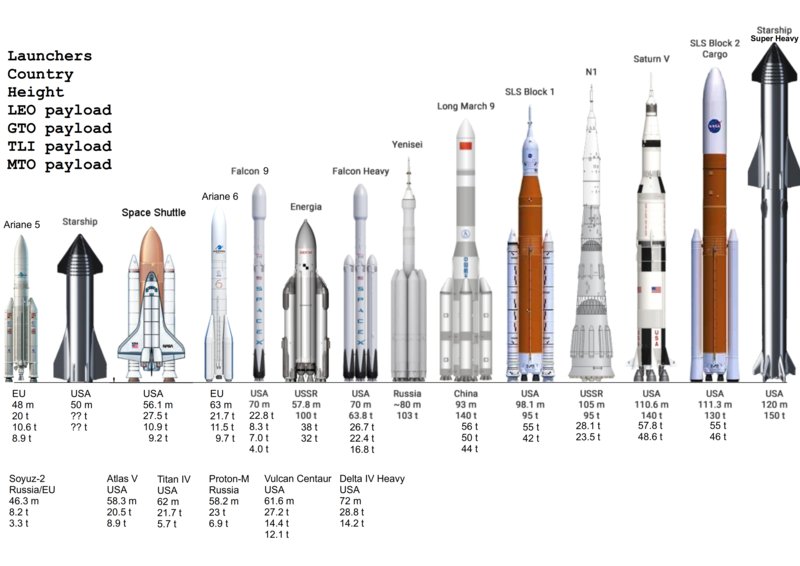Saturn v Compared to Starship

In the realm of space exploration, two monumental achievements stand out as symbols of humanity’s quest to conquer the cosmos: the Saturn V rocket and SpaceX’s Starship. Both represent significant milestones in our journey beyond Earth’s boundaries. The Saturn V, a marvel of 20th-century engineering, propelled astronauts to the moon during the Apollo missions. In contrast, Starship, with its cutting-edge design and ambitious goals, aims to revolutionize space travel in the 21st century. This article delves into the distinct features, capabilities, and implications of these two iconic spacecraft, highlighting their contributions to our understanding of the universe and the future of space exploration.
Saturn V: A Triumph of the Space Race
The Saturn V rocket, developed by NASA in the 1960s, remains unparalleled in its legacy as the vehicle that carried humans to the moon. Standing at a towering height of 363 feet, it boasted a thrust greater than any other rocket in history. Consisting of three stages, each powered by powerful engines, the Saturn V delivered the Apollo spacecraft into Earth’s orbit before embarking on its journey to lunar orbit.
One of the defining characteristics of the Saturn V was its colossal payload capacity, enabling it to transport the lunar module and command module along with supplies essential for lunar exploration. The Apollo missions, particularly Apollo 11, demonstrated the Saturn V’s reliability and capability, culminating in Neil Armstrong and Buzz Aldrin’s historic moonwalk.
Despite its monumental achievements, the Saturn V was a product of its time, relying on expendable rocket stages and conventional propulsion technologies. Its development and operation incurred substantial costs, limiting the frequency and accessibility of manned space missions. However, its success paved the way for future endeavors and inspired generations to dream of reaching beyond Earth’s confines.
Starship: Redefining Space Travel
In contrast to the Saturn V’s towering presence, Starship represents a sleek and futuristic approach to space exploration. Developed by SpaceX under the leadership of Elon Musk, Starship aims to revolutionize space travel through its reusability, versatility, and ambitious goals of interplanetary colonization.
At first glance, Starship’s stainless steel exterior and unconventional design may seem a departure from traditional rocketry. However, its innovative features, including its fully reusable architecture and advanced propulsion systems, set it apart as a paradigm shift in space transportation.
One of Starship’s most revolutionary aspects is its ability to perform rapid and frequent launches, significantly reducing the cost of space access. Unlike the Saturn V, which was discarded after each mission, Starship is designed for multiple uses, with the goal of achieving a high flight rate akin to commercial airliners.
Moreover, Starship’s immense payload capacity surpasses that of the Saturn V, enabling it to carry not only crewed missions to the moon and Mars but also deploy satellites, conduct space tourism, and facilitate cargo resupply missions to the International Space Station (ISS).
Comparison and Implications
While the Saturn V and Starship differ significantly in their design, technology, and era of development, both represent seminal achievements in the history of space exploration. The Saturn V’s success in the Apollo missions showcased humanity’s capability to reach celestial bodies beyond Earth, while Starship heralds a new era of accessibility and sustainability in space travel.
In terms of payload capacity, Starship outshines the Saturn V, offering greater versatility and potential for diverse mission profiles. Its reusable design and emphasis on cost efficiency hold the promise of democratizing space access, opening avenues for commercial ventures, scientific research, and human settlement beyond Earth.
However, the Saturn V’s historical significance and enduring legacy cannot be overstated. Its role in the Apollo program inspired a generation of scientists, engineers, and dreamers, laying the groundwork for future exploration endeavors. The lessons learned from the Saturn V continue to inform the development of next-generation space technologies, including Starship.
Conclusion
The juxtaposition of the Saturn V and Starship underscores the evolution of space exploration from its pioneering days to a future defined by innovation, collaboration, and the relentless pursuit of knowledge. Whether gazing at the footprints left on the lunar surface or envisioning humans walking on Mars, these iconic spacecraft remind us of the indomitable spirit of exploration that propels humanity to reach for the stars.




